Taylor D.A. Introduction to marine engineering
Подождите немного. Документ загружается.

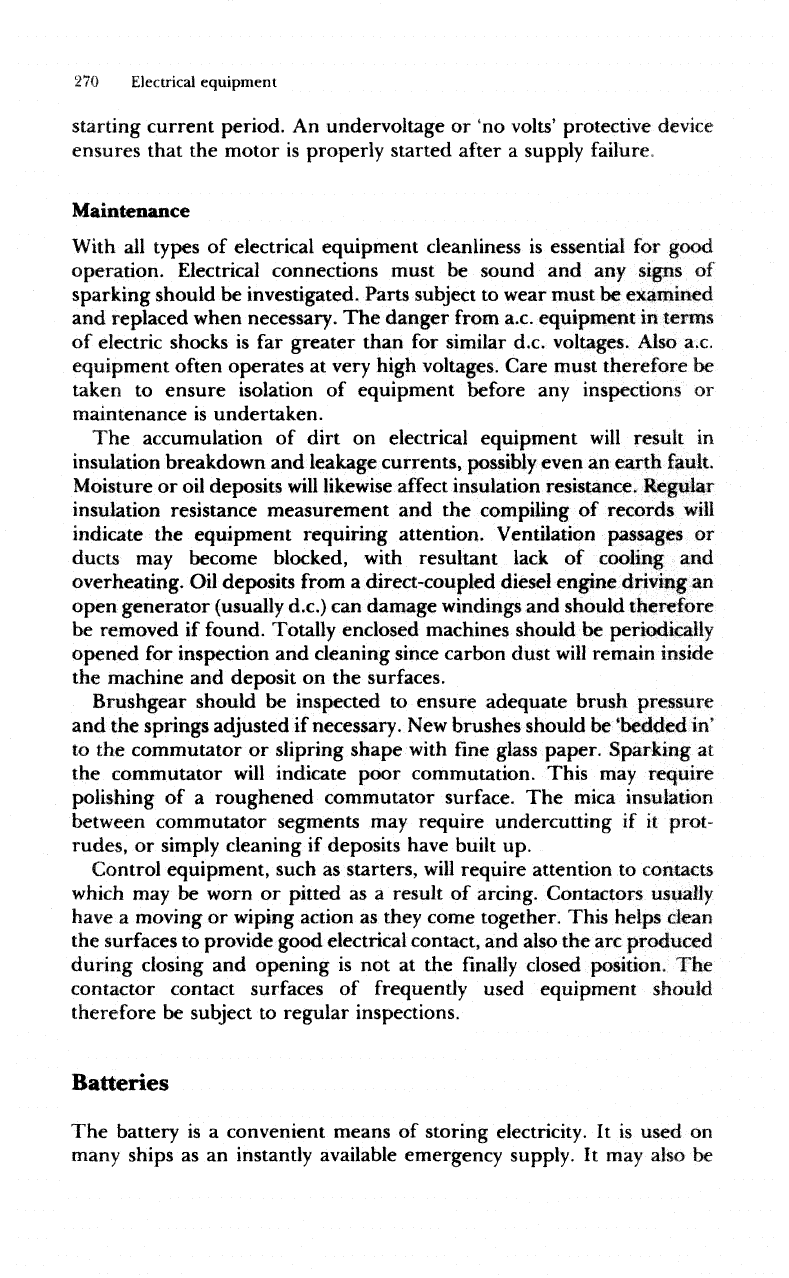
270
Electrical
equipment
starting
current period.
An
undervoltage
or
'no
volts' protective device
ensures that
the
motor
is
properly started after
a
supply
failure,
Maintenance
With
all
types
of
electrical equipment cleanliness
is
essential
for
good
operation.
Electrical connections must
be
sound
and any
signs
of
sparking should
be
investigated. Parts subject
to
wear must
be
examined
and
replaced when necessary.
The
danger
from
a.c. equipment
in
terms
of
electric shocks
is far
greater than
for
similar d.c. voltages. Also a.c,
equipment
often
operates
at
very
high voltages. Care
must
therefore
be
taken
to
ensure isolation
of
equipment before
any
inspections
or
maintenance
is
undertaken.
The
accumulation
of
dirt
on
electrical equipment
will
result
in
insulation
breakdown
and
leakage currents, possibly even
an
earth
fault.
Moisture
or oil
deposits
will
likewise
affect
insulation resistance. Regular
insulation
resistance measurement
and the
compiling
of
records
will
indicate
the
equipment
requiring
attention. Ventilation
passages
or
ducts
may
become blocked,
with
resultant
lack
of
cooling
and
overheating.
Oil
deposits
from
a
direct-coupled diesel engine driving
an
open
generator
(usually
d.c.)
can
damage windings
and
should therefore
be
removed
if
found. Totally enclosed machines should
be
periodically
opened
for
inspection
and
cleaning since carbon dust
will
remain
inside
the
machine
and
deposit
on the
surfaces.
Brushgear should
be
inspected
to
ensure adequate brush pressure
and the
springs adjusted
if
necessary.
New
brushes should
be
'bedded
in'
to the
commutator
or
slipring shape
with
fine
glass paper. Sparking
at
the
commutator
will
indicate poor commutation. This
may
require
polishing
of a
roughened commutator
surface.
The
mica insulation
between
commutator segments
may
require undercutting
if it
prot-
rudes,
or
simply
cleaning
if
deposits have
built
up.
Control equipment, such
as
starters,
will
require attention
to
contacts
which
may be
worn
or
pitted
as a
result
of
arcing.
Contactors
usually
have
a
moving
or
wiping action
as
they
come together. This helps clean
the
surfaces
to
provide good electrical contact,
and
also
the arc
produced
during closing
and
opening
is not at the
finally
closed position.
The
contactor
contact surfaces
of
frequently
used equipment should
therefore
be
subject
to
regular inspections.
Batteries
The
battery
is a
convenient means
of
storing electricity.
It is
used
on
many
ships
as an
instantly
available
emergency supply.
It may
also
be
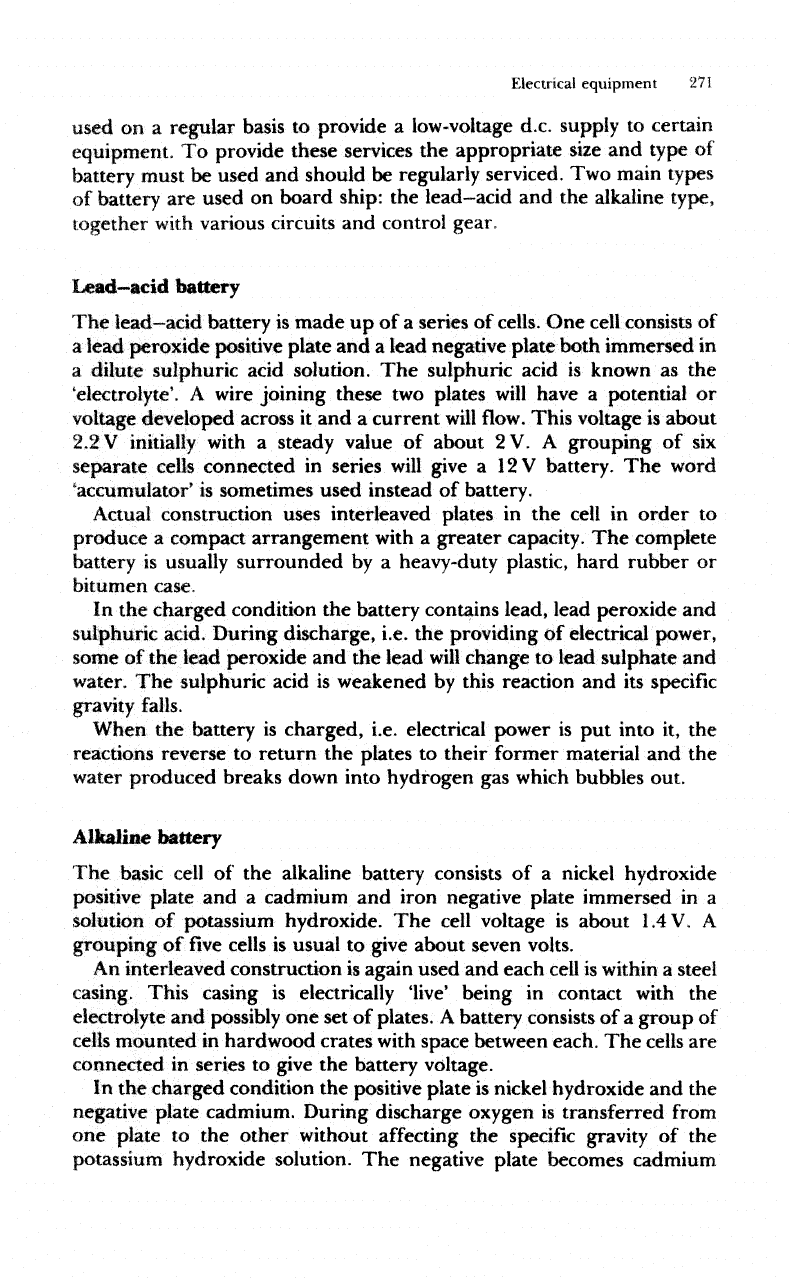
Electrical
equipment
271
used
on a
regular basis
to
provide
a
low-voltage d.c. supply
to
certain
equipment.
To
provide these services
the
appropriate size
and
type
of
battery
must
be
used
and
should
be
regularly
serviced.
Two
main types
of
battery
are
used
on
board
ship:
the
lead—acid
and the
alkaline type,
together
with
various circuits
and
control gear.
Lead-acid
battery
The
lead—acid
battery
is
made
up of a
series
of
cells.
One
cell consists
of
a
lead
peroxide
positive plate
and a
lead negative plate both immersed
in
a
dilute sulphuric acid solution.
The
sulphuric acid
is
known
as the
'electrolyte*.
A
wire joining these
two
plates
will
have
a
potential
or
voltage
developed across
it and a
current
will
flow.
This voltage
is
about
2.2V
initially
with
a
steady value
of
about
2V. A
grouping
of six
separate cells connected
in
series
will
give
a
12V
battery.
The
word
'accumulator*
is
sometimes used instead
of
battery.
Actual
construction uses interleaved plates
in the
cell
in
order
to
produce
a
compact arrangement
with
a
greater
capacity.
The
complete
battery
is
usually surrounded
by a
heavy-duty plastic, hard rubber
or
bitumen
case.
In
the
charged
condition
the
battery contains lead, lead peroxide
and
sulphuric acid. During discharge, i.e.
the
providing
of
electrical power,
some
of the
lead
peroxide
and the
lead
will
change
to
lead sulphate
and
water.
The
sulphuric acid
is
weakened
by
this reaction
and its
specific
gravity
falls.
When
the
battery
is
charged, i.e. electrical power
is put
into
it, the
reactions
reverse
to
return
the
plates
to
their
former material
and the
water
produced breaks down into hydrogen
gas
which bubbles out.
Alkaline
battery
The
basic cell
of the
alkaline battery consists
of a
nickel
hydroxide
positive plate
and a
cadmium
and
iron negative plate immersed
in a
solution
of
potassium
hydroxide.
The
cell voltage
is
about
1.4V.
A
grouping
of five
cells
is
usual
to
give about seven volts.
An
interleaved construction
is
again used
and
each cell
is
within
a
steel
casing.
This
casing
is
electrically
'live'
being
in
contact
with
the
electrolyte
and
possibly
one set of
plates.
A
battery consists
of a
group
of
cells
mounted
in
hardwood crates
with
space between each.
The
cells
are
connected
in
series
to
give
the
battery voltage.
In
the
charged condition
the
positive plate
is
nickel hydroxide
and the
negative
plate cadmium. During discharge oxygen
is
transferred
from
one
plate
to the
other
without
affecting
the
specific gravity
of the
potassium hydroxide solution.
The
negative plate becomes cadmium
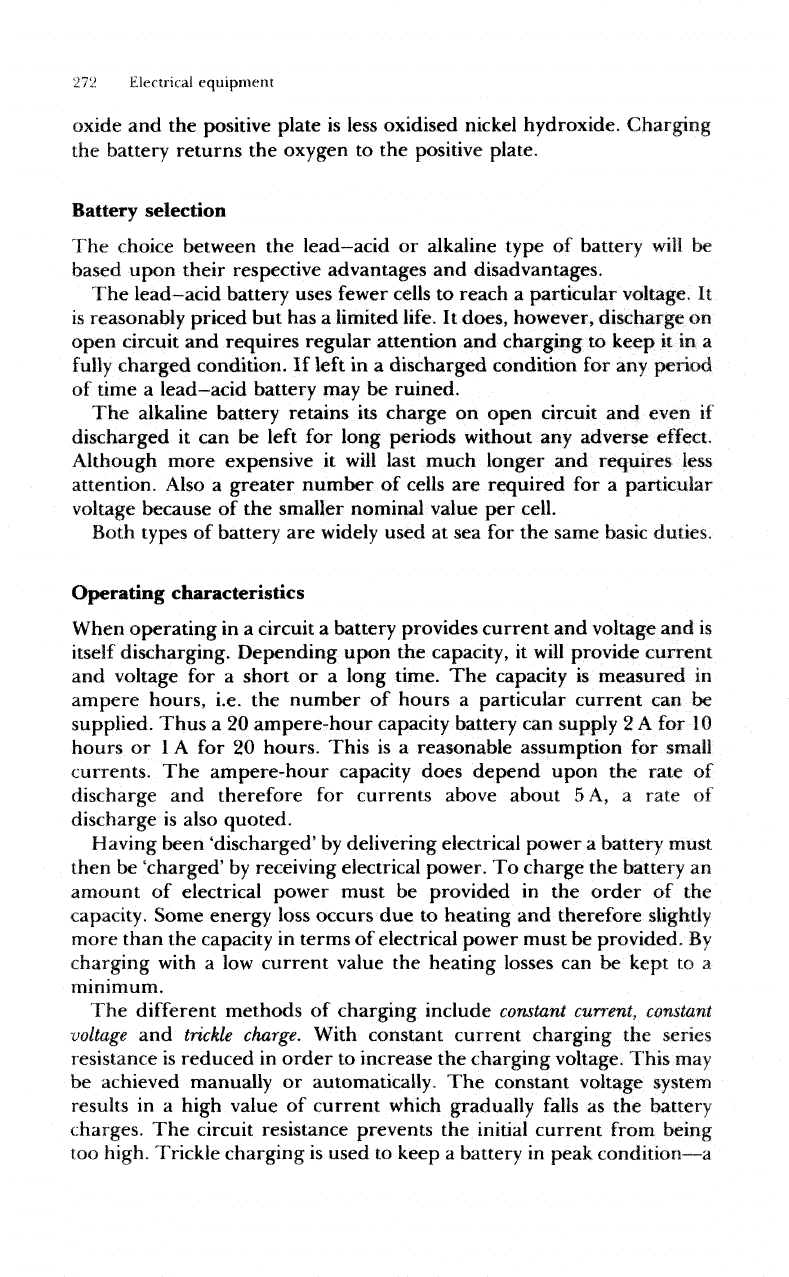
272
Electrical
equipment
oxide
and the
positive plate
is
less
oxidised nickel hydroxide.
Charging
the
battery returns
the
oxygen
to the
positive plate.
Battery
selection
The
choice between
the
lead—acid
or
alkaline type
of
battery
will
be
based upon their respective advantages
and
disadvantages.
The
lead-acid
battery uses fewer cells
to
reach
a
particular
voltage.
It
is
reasonably
priced
but has a
limited
life.
It
does,
however, discharge
on
open circuit
and
requires
regular
attention
and
charging
to
keep
it
in
a
fully
charged condition.
If
left
in a
discharged condition
for any
period
of
time
a
lead-acid
battery
may be
ruined.
The
alkaline battery retains
its
charge
on
open circuit
and
even
if
discharged
it can be
left
for
long
periods
without
any
adverse
effect.
Although
more expensive
it
will
last much longer
and
requires
less
attention.
Also
a
greater
number
of
cells
are
required
for a
particular
voltage
because
of the
smaller nominal value
per
cell.
Both
types
of
battery
are
widely
used
at sea for the
same basic duties.
Operating characteristics
When
operating
in a
circuit
a
battery provides current
and
voltage
and is
itself
discharging. Depending upon
the
capacity,
it
will
provide current
and
voltage
for a
short
or a
long time.
The
capacity
is
measured
in
ampere hours, i.e.
the
number
of
hours
a
particular current
can be
supplied.
Thus
a 20
ampere-hour capacity battery
can
supply
2 A for
10
hours
or 1 A for 20
hours. This
is a
reasonable assumption
for
small
currents.
The
ampere-hour capacity
does
depend
upon
the
rate
of
discharge
and
therefore
for
currents above about
5
A, a
rate
of
discharge
is
also quoted.
Having
been
'discharged'
by
delivering electrical power
a
battery must
then
be
'charged'
by
receiving electrical power.
To
charge
the
battery
an
amount
of
electrical power must
be
provided
in the
order
of the
capacity.
Some energy loss occurs
due
to
heating
and
therefore
slightly
more
than
the
capacity
in
terms
of
electrical power must
be
provided.
By
charging
with
a low
current value
the
heating losses
can be
kept
to
a
minimum.
The
different
methods
of
charging include
constant
current,
constant
voltage
and
trickle
charge.
With constant current charging
the
series
resistance
is
reduced
in
order
to
increase
the
charging voltage. This
may
be
achieved manually
or
automatically.
The
constant voltage system
results
in a
high value
of
current
which
gradually
falls
as the
battery
charges.
The
circuit resistance prevents
the
initial
current from being
too
high. Trickle charging
is
used
to
keep
a
battery
in
peak
condition—a
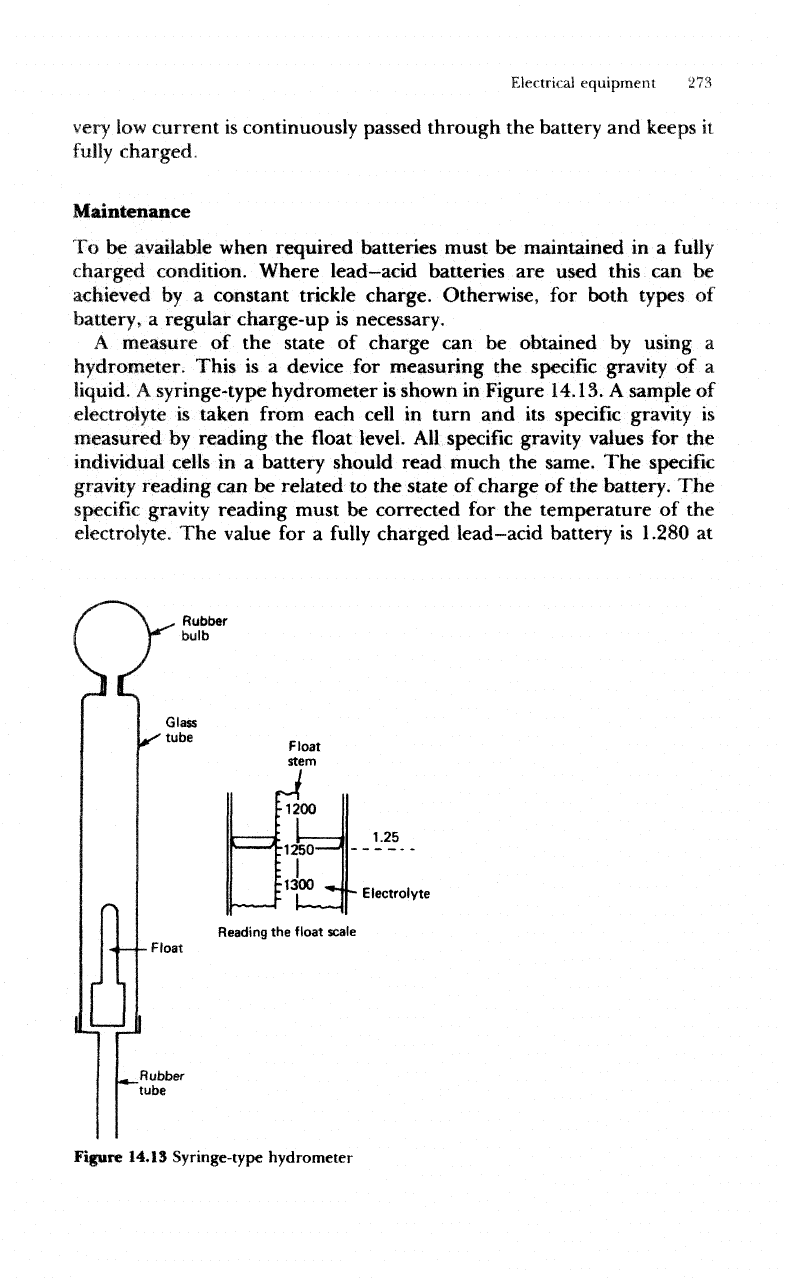
Electrical
equipment
273
very
low
current
is
continuously passed through
the
battery
and
keeps
it
fully
charged.
Maintenance
To be
available when required
batteries
must
be
maintained
in a
fully
charged condition. Where
lead—acid
batteries
are
used this
can be
achieved
by a
constant trickle charge. Otherwise,
for
both types
of
battery,
a
regular charge-up
is
necessary.
A
measure
of the
state
of
charge
can be
obtained
by
using
a
hydrometer. This
is a
device
for
measuring
the
specific
gravity
of a
liquid.
A
syringe-type hydrometer
is
shown
in
Figure
14.13.
A
sample
of
electrolyte
is
taken
from
each cell
in
turn
and its
specific
gravity
is
measured
by
reading
the float
level.
All
specific
gravity
values
for the
individual
cells
in
a
battery should read much
the
same.
The
specific
gravity
reading
can be
related
to the
state
of
charge
of the
battery.
The
specific
gravity
reading must
be
corrected
for the
temperature
of the
electrolyte.
The
value
for a
fully
charged
lead-acid
battery
is
1.280
at
Glass
tube
Float
stem
1
„
r-f
•1200
;
1—
-
:1250
'
•
I
:1300
,*.
1.25
*-
Electrolyte
•
Float
Reading
the
float
scale
PJ
^_
Rubber
tube
Figure
14.13
Syringe-type
hydrometer
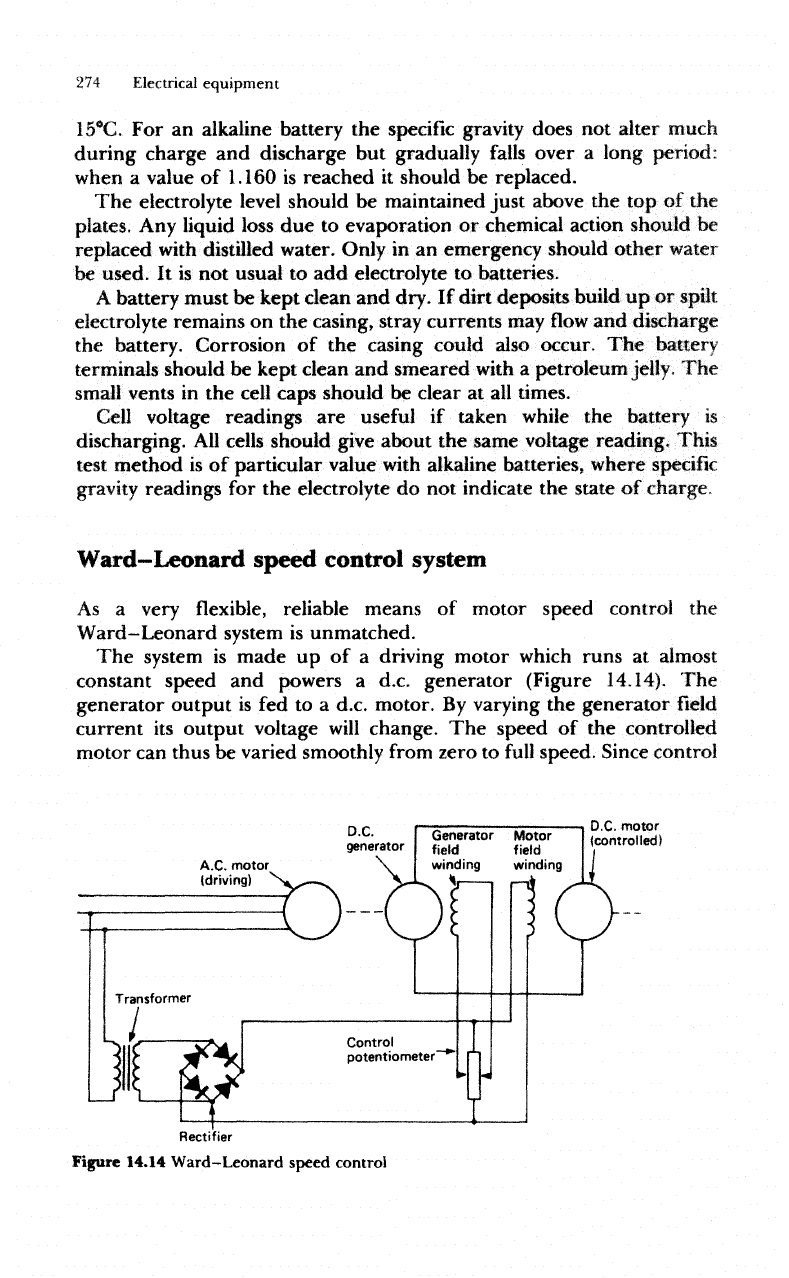
274
Electrical equipment
15°C.
For an
alkaline battery
the
specific gravity does
not
alter
much
during charge
and
discharge
but
gradually
falls
over
a
long
period:
when
a
value
of
1.160
is
reached
it
should
be
replaced.
The
electrolyte
level
should
be
maintained just above
the top of the
plates.
Any
liquid loss
due to
evaporation
or
chemical action should
be
replaced
with
distilled
water. Only
in an
emergency should
other
water
be
used.
It is not
usual
to
add
electrolyte
to
batteries.
A
battery must
be
kept clean
and
dry.
If
dirt
deposits
build
up or
spilt
electrolyte remains
on the
casing, stray currents
may
flow
and
discharge
the
battery. Corrosion
of the
casing could also occur.
The
battery
terminals should
be
kept clean
and
smeared
with
a
petroleum
jelly.
The
small
vents
in the
cell caps should
be
clear
at all
times.
Cell
voltage readings
are
useful
if
taken
while
the
battery
is
discharging.
All
cells should give about
the
same voltage reading,
This
test method
is
of
particular
value
with
alkaline batteries, where specific
gravity
readings
for the
electrolyte
do not
indicate
the
state
of
charge.
Ward—Leonard
speed
control
system
As
a
very
flexible,
reliable means
of
motor speed
control
the
Ward-Leonard
system
is
unmatched.
The
system
is
made
up of a
driving motor
which
runs
at
almost
constant speed
and
powers
a
d.c.
generator (Figure 14.14).
The
generator
output
is fed to a
d.c.
motor.
By
varying
the
generator
field
current
its
output voltage
will
change.
The
speed
of the
controlled
motor
can
thus
be
varied smoothly
from
zero
to
full
speed.
Since control
D.C.
motor
(controlled)
Rectifier
Figure
14.14 Ward-Leonard speed
control
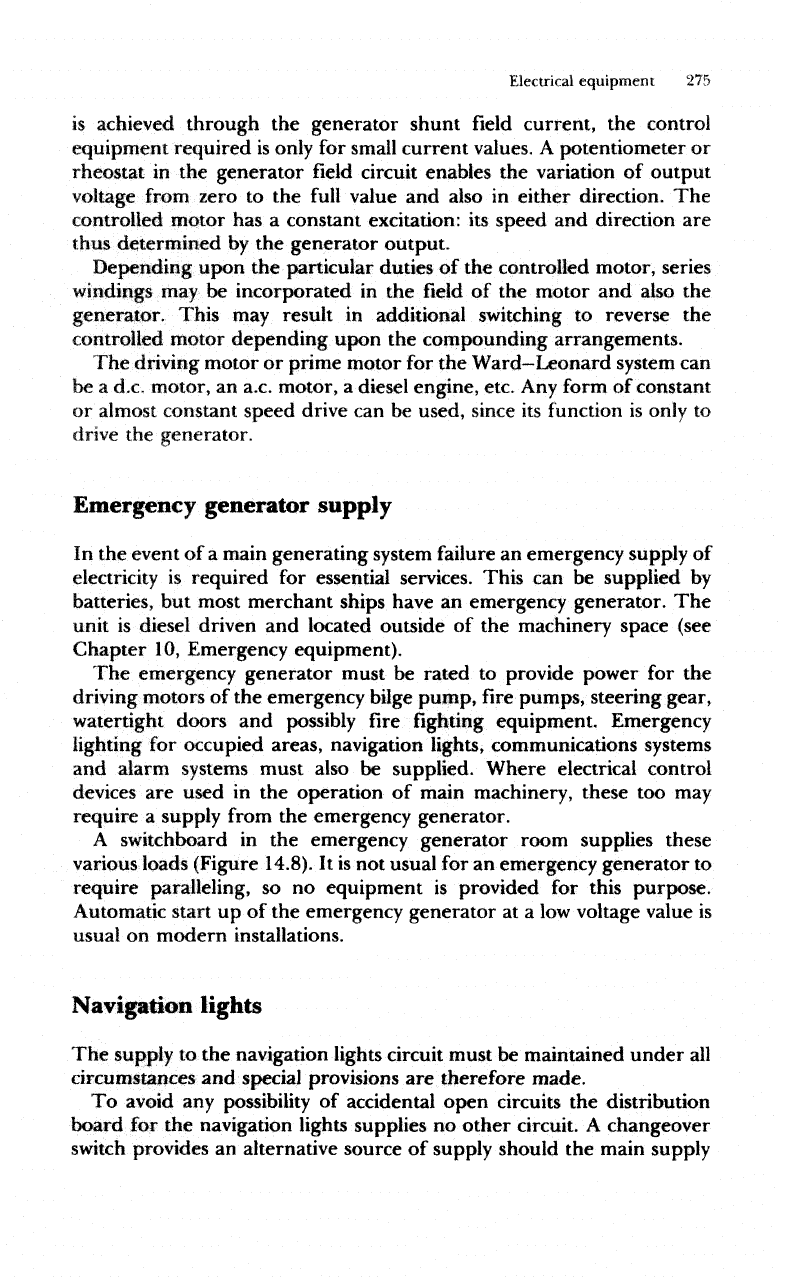
Electrical
equipment
275
is
achieved through
the
generator shunt
field
current,
the
control
equipment
required
is
only
for
small
current values.
A
potentiometer
or
rheostat
in the
generator
field
circuit enables
the
variation
of
output
voltage
from
zero
to the
full
value
and
also
in
either direction.
The
controlled motor
has a
constant excitation:
its
speed
and
direction
are
thus
determined
by the
generator output.
Depending upon
the
particular duties
of the
controlled motor, series
windings
may be
incorporated
in the field of the
motor
and
also
the
generator.
This
may
result
in
additional switching
to
reverse
the
controlled motor depending upon
the
compounding arrangements.
The
driving
motor
or
prime
motor
for the
Ward—Leonard
system
can
be a
d.c. motor,
an
a.c. motor,
a
diesel engine, etc.
Any
form
of
constant
or
almost constant speed drive
can be
used, since
its
function
is
only
to
drive
the
generator.
In
the
event
of a
main generating system
failure
an
emergency supply
of
electricity
is
required
for
essential services.
This
can be
supplied
by
batteries,
but
most merchant ships have
an
emergency
generator.
The
unit
is
diesel driven
and
located outside
of the
machinery space (see
Chapter
10,
Emergency equipment).
The
emergency generator
must
be
rated
to
provide power
for the
driving
motors
of the
emergency bilge pump,
fire
pumps, steering gear,
watertight
doors
and
possibly
fire
fighting
equipment. Emergency
lighting
for
occupied areas,
navigation
lights,
communications systems
and
alarm systems must also
be
supplied. Where electrical control
devices
are
used
in the
operation
of
main
machinery, these
too may
require
a
supply
from
the
emergency generator.
A
switchboard
in the
emergency generator room supplies these
various
loads (Figure
14.8).
It is not
usual
for an
emergency
generator
to
require
paralleling,
so no
equipment
is
provided
for
this
purpose.
Automatic
start
up of the
emergency generator
at a low
voltage value
is
usual
on
modern
installations.
Navigation
lights
The
supply
to the
navigation lights circuit must
be
maintained under
all
circumstances
and
special provisions
are
therefore
made.
To
avoid
any
possibility
of
accidental open circuits
the
distribution
board
for the
navigation lights supplies
no
other
circuit.
A
changeover
switch
provides
an
alternative source
of
supply
should
the
main
supply
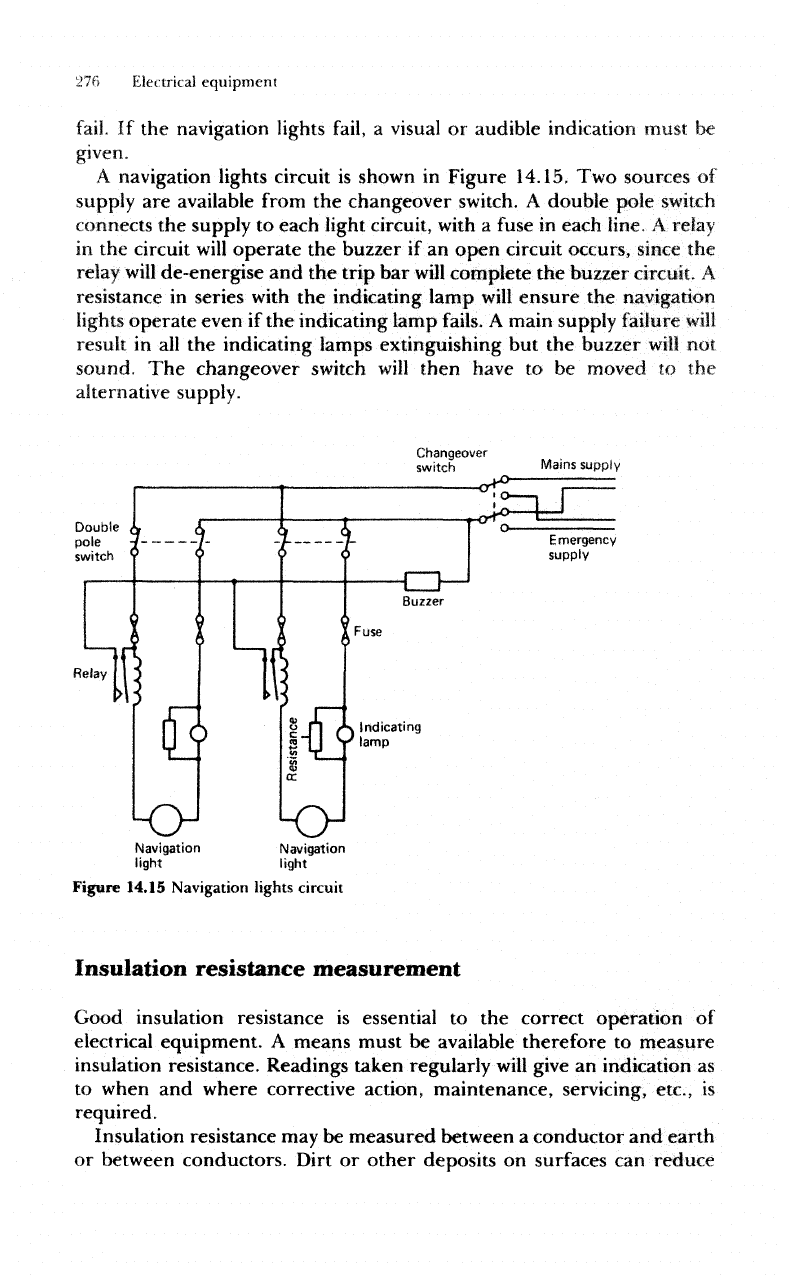
276
Electrical
equipment
fail.
If the
navigation lights
fail,
a
visual
or
audible indication must
be
given.
A
navigation lights circuit
is
shown
in
Figure
14.15.
Two
sources
of
supply
are
available from
the
changeover switch.
A
double
pole
switch
connects
the
supply
to
each light circuit, with
a
fuse
in
each
line,
A
relay
in
the
circuit
will
operate
the
buzzer
if an
open
circuit occurs,
since
the
relay
will
de-energise
and the
trip
bar
will
complete
the
buzzer circuit.
A
resistance
in
series
with
the
indicating lamp
will
ensure
the
navigation
lights
operate
even
if the
indicating lamp
fails.
A
main supply
failure
will
result
in all the
indicating lamps extinguishing
but the
buzzer
will
not
sound.
The
changeover
switch
will
then have
to be
moved
to the
alternative
supply.
Changeover
switch
of?
Mains
supply
Double
pole
switch
Relay
Kr
Navigation
light
Figure 14.15 Navigation lights circuit
Navigation
light
Insulation
resistance
measurement
Good
insulation resistance
is
essential
to the
correct
operation
of
electrical equipment.
A
means must
be
available therefore
to
measure
insulation
resistance. Readings taken regularly
will
give
an
indication
as
to
when
and
where corrective action, maintenance, servicing, etc.,
is
required.
Insulation
resistance
may be
measured
between
a
conductor
and
earth
or
between
conductors.
Dirt
or
other
deposits
on
surfaces
can
reduce

Control coi!
Control
circuit
resistance
Electrical
equipment
27'
Permanent
magnet
rotor
Deflecting
circuit
resistance
Figure
14.16
Insulation
tester
insulation
resistance
and
cause
a
leakage current
or
'tracking'
to
occur.
Equipment
must therefore
be
kept clean
in
order
to
ensure high values,
in
megohms,
of
insulation resistance.
Insulation
is
classified
in
relation
to the
maximum temperature
at
which
it is
safe
for the
equipment
or
cables
to
operate.
Classes
A
(55°C),
E
(70°C)
and B
(80°C)
are
used
for
marine equipment.
One
instrument used
for
insulation testing
is
shown
in
Figure 14.16.
Its
trade name
is
'Megger
Tester'.
A
permanent magnet provides
a
magnetic
field for a
pivoted
core
which
is
wound
with
two
coils.
A
needle
or
pointer
is
pivoted
at the
centre
of
rotation
of the
coils
and
moves
when
they
do. The two
coils
are
wound
at
right angles
to
each
other
and
connected
in
such
a way
that
one
measures voltage
and the
other
measures current.
The
needle deflection
is a
result
of the
opposing
effects
of the two
coils
which
gives
a
reading
of
insulation resistance.
A
hand
driven generator provides
a
test voltage
to
operate
the
instrument.
Test
probes
are
used
to
measure
the
resistance
at the
desired points.
Electrical
hazards
The
resistance
of the
human body
is
quite high
only
when
the
skin
is
dry.
The
danger
of
electric shock
is
therefore much greater
for
persons
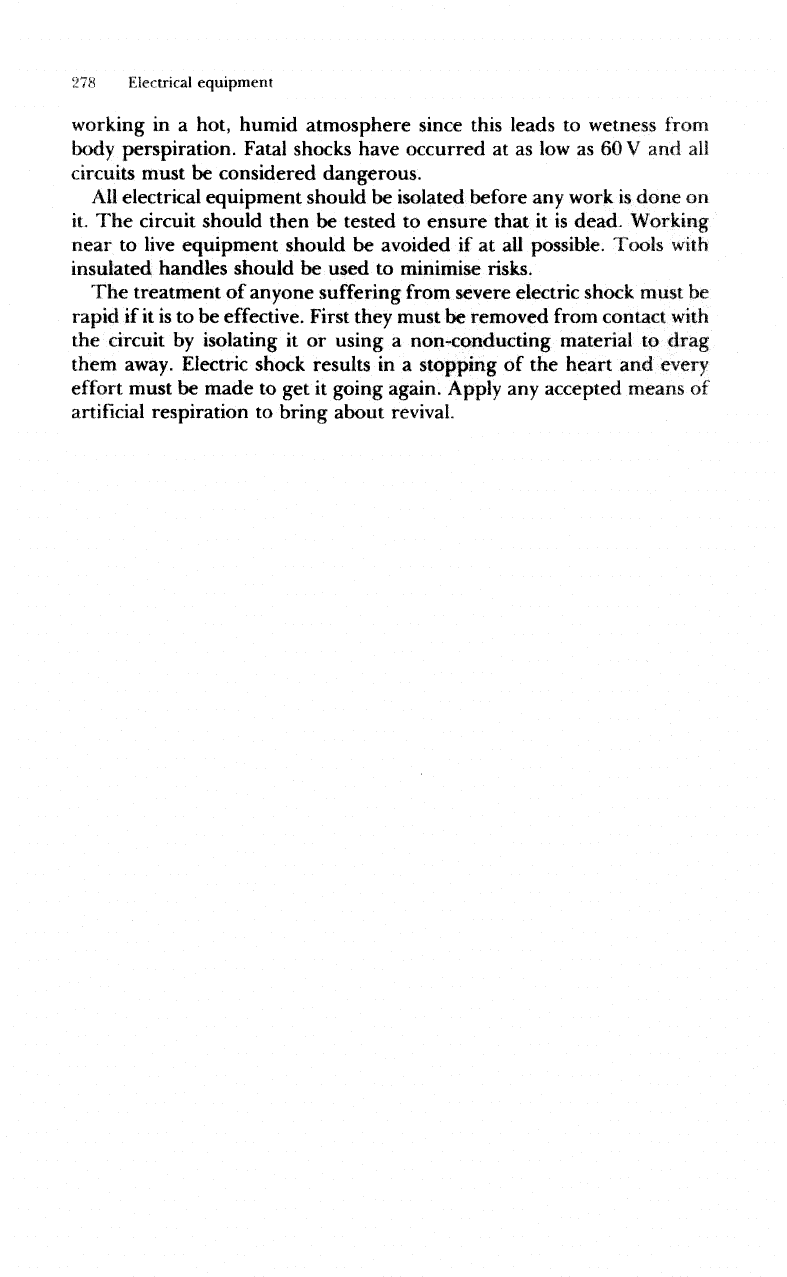
278
Electrical equipment
working
in a
hot, humid atmosphere since this leads
to
wetness
from
body
perspiration. Fatal shocks have occurred
at as low as
60V
and all
circuits
must
be
considered dangerous.
All
electrical equipment should
be
isolated
before
any
work
is
done
on
it.
The
circuit should then
be
tested
to
ensure that
it is
dead.
Working
near
to
live
equipment
should
be
avoided
if at all
possible. Tools
with
insulated handles should
be
used
to
minimise
risks.
The
treatment
of
anyone
suffering
from
severe electric shock
must
be
rapid
if it is to be
effective.
First they must
be
removed
from
contact
with
the
circuit
by
isolating
it or
using
a
non-conducting material
to
drag
them
away.
Electric shock results
in a
stopping
of the
heart
and
every
effort
must
be
made
to get it
going again.
Apply
any
accepted means
of
artificial
respiration
to
bring about
revival.
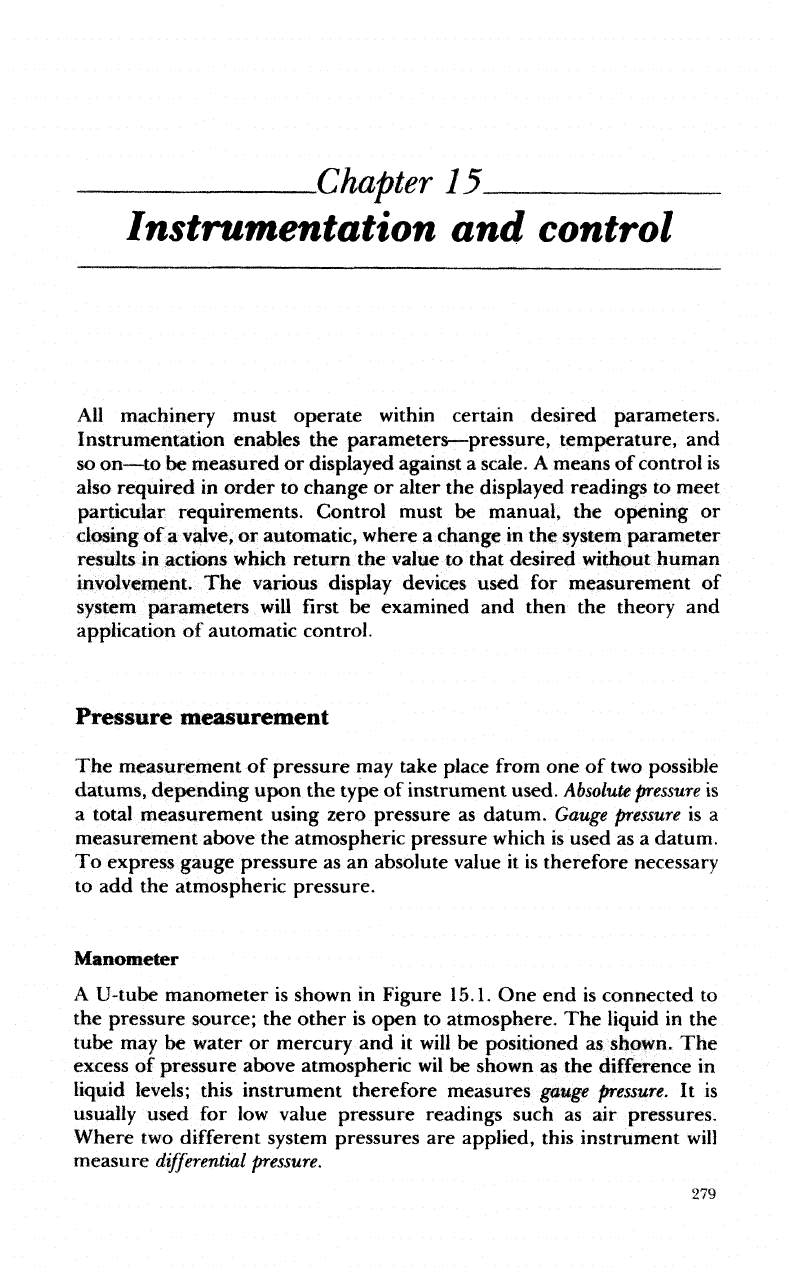
_
Chapter
15
Instrumentation
and
control
All
machinery must
operate
within
certain desired parameters.
Instrumentation enables
the
parameters—pressure,
temperature,
and
so
on—to
be
measured
or
displayed against
a
scale.
A
means
of
control
is
also
required
in
order
to
change
or
alter
the
displayed readings
to
meet
particular requirements. Control must
be
manual,
the
opening
or
closing
of a
valve,
or
automatic, where
a
change
in the
system parameter
results
in
actions which return
the
value
to
that desired without human
involvement.
The
various display devices used
for
measurement
of
system
parameters
will
first be
examined
and
then
the
theory
and
application
of
automatic control.
Pressure
measurement
The
measurement
of
pressure
may
take place
from
one of two
possible
datums,
depending
upon
the
type
of
instrument used.
Absolute
pressure
is
a
total measurement using zero pressure
as
datum.
Gauge pressure
is a
measurement above
the
atmospheric pressure
which
is
used
as a
datum.
To
express gauge pressure
as an
absolute
value
it is
therefore necessary
to
add the
atmospheric pressure.
Manometer
A
U-tube
manometer
is
shown
in
Figure
15.1.
One end is
connected
to
the
pressure source;
the
other
is
open
to
atmosphere.
The
liquid
in the
tube
may be
water
or
mercury
and it
will
be
positioned
as
shown.
The
excess
of
pressure above atmospheric
wil
be
shown
as the
difference
in
liquid
levels; this instrument therefore measures
gauge pressure.
It is
usually
used
for low
value pressure readings
such
as air
pressures.
Where
two
different
system pressures
are
applied,
this
instrument
will
measure
differential
pressure.
279
